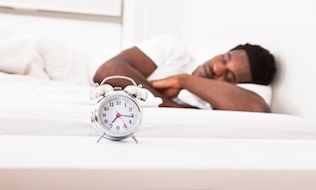

Canadians aren’t getting enough sleep and their employers are feeling the pinch, participants at the Benefits and Pension Summit in Toronto heard today.
“Sleep is not a luxury. It’s a necessity as vital as eating, drinking and exercising,” said Josée Dixon, executive vice-president of group and business insurance at Desjardins Insurance.
Yet 75 per cent of Canadian adults sleep less than seven hours a night, 40 per cent suffer from a sleep disorder and only 13 per cent seek help. The most common disorders are trouble sleeping (difficulty falling and staying asleep), chronic insomnia (trouble sleeping at least three times a week for three or more months), and sleep apnea. At work, those issues can lead to lost productivity, absenteeism, presenteeism, workplace injuries and more claims on a group benefits plan.
Read: Almost a third of employees go to work tired: study
“There is no doubt employers pay a high price,” said Dixon. She also pointed to research that found a worker with a sleep disorder suffers from presenteeism for 28 days a year, compared to three days for a good sleeper. On average, employers lose $5,000 a year in lost productivity from troubled sleepers. They also pay 75 per cent more in health-care costs.
Employees with sleep disorders “continue to be exhausted, they continue to be depressed, they see more doctors, they take more pills and they go off work,” said Dixon.
To address the problem, employers should encourage rest and rejuvenation and not create a culture that rewards working around they clock. They can also promote short naps while on company time, as research has found they can improve creativity and memory. But it’s important to ensure nap time doesn’t extend past 3 p.m. to ensure it doesn’t interfere with employees’ sleep at night.
Read: Getting a good night’s sleep: Easy as z-z-z?
Desjardins has also partnered with Haleo Preventive Health Solutions, a startup that helps employees find effective treatment for sleep disorders.
“There are literally millions of people worldwide who are hooked on pills to help them sleep, but they don’t address the root cause,” said Haleo founder Bradley Smith during the conference. He noted that when he was working in marketing for a French pharmaceutical company, it spent no money on advertising its over-the-counter sleeping pill but it still sold millions a year.
Read: Work stress steals sleep
Haleo’s system works by first inviting all of an organization’s employees to take an online screening test about their sleep habits. For those employees deemed to be at risk, the program will let them know and ask for their consent for Haleo to contact them. If they agree, they’ll be able to participate in employer-sponsored treatment. For those with trouble sleeping, it includes one evaluation session and four treatments through video conferencing. For those with sleep apnea, Haleo will direct them to a partner clinic for in-person care.
Haleo is currently running a pilot program with Desjardins employees and has seen a 35 per cent participation rate. Of those deemed to be at risk, 80 per cent agree for Haleo to contact them.
Read: RBC to share focus on sleep at 2017 Benefits and Pension Summit
Conference attendees also heard from Andrejka Massicotte, director of Canadian benefits and wellness at the Royal Bank of Canada. In October 2015, the bank focused its wellness campaign on the link between sleep and mental health.
Since RBC’s employees work at many different locations, the campaign took place online. The bank developed a drag-and-drop game to show what makes a good sleep environment and another activity that taught visualization, relaxation and deep breathing techniques. It also hosted a mindfulness webinar, created an online community so employees could share sleep tips and sent out frequent sleep-related polls to drive engagement.
Roughly 14,400 employees participated in the program. About 12,000 completed the full campaign, thereby becoming eligible for prizes and wellness credits.
Encouraging employees to make “little, actionable changes” was more effective because the changes were more likely to last, Massicotte said.
